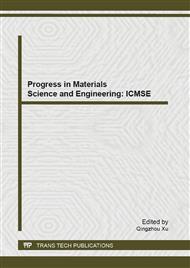[1]
W. Barthlott, C. Neinhuis, Purity of the sacred lotus, or escape from contamination in biological surfaces, Planta. 202 (1997) 1-8.
DOI: 10.1007/s004250050096
Google Scholar
[2]
A. Nakajima, K. Abe, K. Hashimoto, T. Watanabe, Preparation of hard super-hydrophobic films with visible light transmission, Thin Solid Films. 376 (2000) 140-143.
DOI: 10.1016/s0040-6090(00)01417-6
Google Scholar
[3]
A. Nakajima, K. Hashimoto, T. Watanabe, K. Takai, G. Yamauchi and A. Fujishima, Transparent superhydrophobic thin films with self-Cleaning properties, Langmuir. 16 (2000) 7044-7047.
DOI: 10.1021/la000155k
Google Scholar
[4]
X. Gao, X. Yan, X. Yao, L. Xu, K. Zhang, J. Zhang, B. Yang and L. Jiang, The dry-style antifogging properties of mosquito compound eyes and artificial analogues prepared by soft lithography, Advanced materials. 19 (2007) 2213-2217.
DOI: 10.1002/adma.200601946
Google Scholar
[5]
F. Zhang, L. Zhao, H. Chen, S. Xu, D. G. Evans and X. Duan, Corrosion resistance of superhydrophobic layered double hydroxide films on aluminum, Angew. Chem. Int. Ed. 47 (2008) 2466-2469.
DOI: 10.1002/anie.200704694
Google Scholar
[6]
H. Liu, S. Szunerits, W. Xu and R. Boukherroub, Preparation of superhydrophobic coatings on Zinc as effective corrosion barriers, ACS Appl. Mater. Interfaces. 1 (2009) 1150-1153.
DOI: 10.1021/am900100q
Google Scholar
[7]
T. Ishizaki, Y. Masuda and M. Sakamoto, Corrosion resistance and durability of superhydrophobic surface formed on magnesium alloy coated with nanostructured cerium oxide film and fluoroalkylsilane molecules in corrosive NaCl aqueous solution, Langmuir. 27 (2011).
DOI: 10.1021/la2002783
Google Scholar
[8]
L. Feng, S. Li, H. Li, et al, Super-hydrophobic surface of aligned polyacrylonitrile nanofibers, Angew. Chem. 114 (2002) 1269-1271.
DOI: 10.1002/1521-3757(20020402)114:7<1269::aid-ange1269>3.0.co;2-e
Google Scholar
[9]
K. Tadanaga, J. Morinaga, T. Minami, Formation of superhydrophobic-superhydrophilic pattern on flowerlike alumina thin film by the Sol-Gel method, J. Sol-Gel SciTechnol. 19 (2000) 211-214.
DOI: 10.1021/cm990643h
Google Scholar
[10]
B. T. Qian and Z. Q. Shen, Fabrication of superhydrophobic surfaces by dislocation-selective chemical etching on aluminum, copper, and zinc substrates, Langmuir. 21 (2005) 9007-9009.
DOI: 10.1021/la051308c
Google Scholar
[11]
O. U. Nimittrakoolchai, S. Supothina, Polymer-based superhydrophobic coating fabricated from polyelectrolyte multilayers of poly (allylamin e hydrochloride) and poly (acrylic acid), Macromol. Symp. 264 (2008) 73-79.
DOI: 10.1002/masy.200850412
Google Scholar
[12]
L. Jiang, Y. Zhao, J. Zhai, A lotus-leaf-like superhydrophobic surface: A porous Microsphere / nanofiber composite film prepared by electrohydrodynamics, Angew, Chem. Int. Ed. 43 (2004) 4338-4341.
DOI: 10.1002/anie.200460333
Google Scholar
[13]
H. Y. Erbil, A. L. Demirel, Y. Avci, et al, Transformation of a Simple Plastic into a Superhydrophobic Surface, Science. 299 (2003) 1377-1380.
DOI: 10.1126/science.1078365
Google Scholar
[14]
P. N. Manoudis, I. Karapanagiotis, A. Tsakalof, et al, Superhydrophobic composite films produced on various substrates, Langmuir. 24 (2008) 11225-11232.
DOI: 10.1021/la801817e
Google Scholar
[15]
R. N. Wenzel, Surface roughness and contact angle (letter), Ind. Eng. Chem. 28 (1936) 988-994.
Google Scholar
[16]
A. B. D. Cassie, S. Baxter, Wettability of porous surfaces, Trans. Faraday Soc. 40 (1944) 546-561.
DOI: 10.1039/tf9444000546
Google Scholar
[17]
X. Deng, L. Mammen, H. J. Butt and D. Vollmer, Candle soot as a template for a transparent robust superamphiphobic coating, Science. 335 (2012) 67-70.
DOI: 10.1126/science.1207115
Google Scholar


